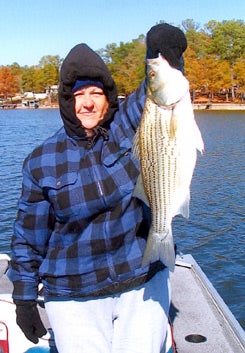SCIENTIFIC NAME:
Morone chrysops x saxatilis
CHARACTERISTICS:
The palmetto bass, also called hybrid striped bass, is not a naturally occurring species. Individuals are produced by artificially spawning a male white bass with a female striped bass. Offspring usually exhibit a wide variety of color patterns which can be confusing when trying to separate them from the young of either parent species. A hybrid bass can usually be distinguished from a striped bass by its broken lateral stripes along the lower sides of the body (continuous on striped bass) and a distinctively shorter, thicker, and deeper body form. Hybrid bass can be distinguished from white bass by its two tooth patches on the tongue, as opposed to only one tooth patch on the white bass. As they grow older, hybrid bass become thicker and deeper-bodied, giving them a distinctive short and stocky appearance.
ADULT SIZE:
15 to 20 in (380 to 508 mm). The Alabama state angling record for hybrids (25 lb 15 oz) was taken from the Sipsey Fork below Lewis Smith Lake on September 13, 1996. The previous state angling record (23 lb, 2 oz) was caught at Lake Lewis Smith Dam in 1989.
STATE RECORD:
a list of the State Record Freshwater Fish.
DISTRIBUTION:
The ADCNR has stocked more than 18 million hybrid bass in Alabama since 1974 (Nick Nichols, 1995 personal communication). The hybrid bass in probably the most wide ranging and abundant member of the striped bass family in state waters. We have collected individuals throughout the Mobile basin, in the Tennessee River and its larger tributaries, and in several coastal rivers.
HABITAT AND BIOLOGY:
Each spring, biologists with the ADCNR collect white bass males and striped bass females and transport them to a state fish hatchery in Marion where they are spawned. Offspring are subsequently released into rivers, reservoirs, and public lakes. Hybrid bass feed heavily on shad and grow rapidly, often reaching total lengths of 18 inches or more in two years. Individuals migrate great distances in response to changing seasons and flow regimes and they congregate in tailwaters below dams in spring and during high discharge periods. The hybrid bass provides an excellent winter fishery in Alabama when many other game species are relatively inactive. Although they readily strike floating and sinking artificial lures, many fishes are taken with chicken livers and shad as cut bait. Hybrid bass rarely reproduce in nature, but they are known to occasionally back cross with white bass (Etnier and Starnes, 1993).
The copyrighted information above is from Fishes of Alabama and the Mobile Basin







